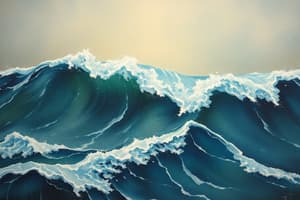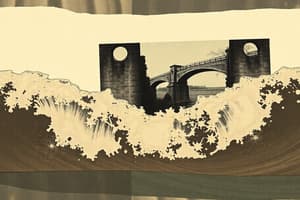Podcast
Questions and Answers
What type of wave is a sound wave?
What type of wave is a sound wave?
- Torsional
- Electromagnetic
- Transverse
- Longitudinal (correct)
What is the relationship between frequency, wavelength, and wave speed?
What is the relationship between frequency, wavelength, and wave speed?
- Wave speed = Frequency / Wavelength
- Wave speed = Frequency + Wavelength
- Wave speed = Frequency - Wavelength
- Wave speed = Frequency x Wavelength (correct)
Which property of a wave is related to its energy?
Which property of a wave is related to its energy?
- Amplitude (correct)
- Frequency
- Wavelength
- Velocity
What phenomenon occurs when two waves overlap and their amplitudes add together?
What phenomenon occurs when two waves overlap and their amplitudes add together?
In what medium do mechanical waves typically travel the fastest?
In what medium do mechanical waves typically travel the fastest?
Flashcards
What is a wave?
What is a wave?
A disturbance that transfers energy through a medium or space.
What are longitudinal waves?
What are longitudinal waves?
Waves where the particle displacement is parallel to the direction of wave propagation.
What is wavelength?
What is wavelength?
The distance between two successive crests or troughs of a wave.
What is frequency?
What is frequency?
Signup and view all the flashcards
What is amplitude?
What is amplitude?
Signup and view all the flashcards
Study Notes
- Waves are disturbances that transfer energy through a medium or space
- There are two main types of waves: transverse and longitudinal
Transverse Waves
- Particles of the medium move perpendicular to the direction of wave propagation
- Examples include light waves, water waves, and waves on a string
- Characterized by crests (highest points) and troughs (lowest points)
Longitudinal Waves
- Particles of the medium move parallel to the direction of wave propagation
- Examples include sound waves and pressure waves
- Characterized by compressions (regions of high density and pressure) and rarefactions (regions of low density and pressure)
Wave Properties
- Wavelength (λ): The distance between two consecutive crests or troughs in a transverse wave, or between two consecutive compressions or rarefactions in a longitudinal wave
- Frequency (f): The number of complete waves (cycles) passing a point per unit time, measured in Hertz (Hz)
- Period (T): The time taken for one complete wave to pass a point. It is the inverse of frequency (T = 1/f)
- Amplitude (A): The maximum displacement of a particle from its equilibrium position
- Wave velocity (v): The speed at which the wave propagates through the medium. It is related to wavelength and frequency by the equation v = fλ
Relationship between Wave Velocity, Frequency, and Wavelength
- The wave velocity (v) is directly proportional to both the frequency (f) and the wavelength (λ)
- The relationship is given by the formula: v = fλ
- Knowing any two of these quantities allows you to calculate the third
Superposition of Waves
- When two or more waves overlap in the same region of space, they interfere with each other
- The principle of superposition states that the resultant displacement at any point is the vector sum of the displacements of the individual waves
- Interference can be constructive (resulting in a larger amplitude) or destructive (resulting in a smaller amplitude or cancellation)
Constructive Interference
- Occurs when waves are in phase, meaning their crests and troughs align
- The amplitude of the resulting wave is the sum of the amplitudes of the individual waves
Destructive Interference
- Occurs when waves are out of phase, meaning the crest of one wave aligns with the trough of another
- The amplitude of the resulting wave is the difference between the amplitudes of the individual waves. If the amplitudes are equal, complete cancellation occurs
Standing Waves
- Formed when two waves of the same frequency and amplitude traveling in opposite directions interfere
- Characterized by nodes (points of zero displacement) and antinodes (points of maximum displacement)
- Occur in fixed mediums, such as strings fixed at both ends or air columns in pipes
Nodes and Antinodes
- Nodes are points where the displacement is always zero
- Antinodes are points where the displacement is maximum
- The distance between two consecutive nodes or two consecutive antinodes is λ/2
Harmonics and Overtones
- Harmonics are the modes of vibration of a system in which the frequencies are integer multiples of the fundamental frequency
- The fundamental frequency is the lowest frequency at which a standing wave can be formed
- Overtones are the frequencies above the fundamental frequency
- In a string fixed at both ends, the frequencies of the harmonics are f, 2f, 3f, ...
- The first harmonic is the fundamental frequency, the second harmonic is the first overtone, and so on
Doppler Effect
- The apparent change in frequency of a wave due to the relative motion between the source and the observer
- If the source and observer are moving towards each other, the observed frequency is higher than the emitted frequency
- If the source and observer are moving away from each other, the observed frequency is lower than the emitted frequency
- Applicable to both sound waves and electromagnetic waves (e.g., light)
Doppler Effect Formula
- For sound waves:
- f' = f (v ± vo) / (v ± vs)
- f' is the observed frequency
- f is the emitted frequency
- v is the speed of sound in the medium
- vo is the velocity of the observer (positive if moving towards the source, negative if moving away)
- vs is the velocity of the source (positive if moving away from the observer, negative if moving towards)
- f' = f (v ± vo) / (v ± vs)
Speed of Sound
- The speed of sound depends on the properties of the medium through which it travels
- In general, sound travels faster in solids than in liquids, and faster in liquids than in gases
- The speed of sound in a gas is affected by temperature: higher temperature means higher speed
Speed of Sound in a Gas
- The speed of sound in a gas is given by:
- v = √(γRT/M)
- v is the speed of sound
- γ is the adiabatic index (ratio of specific heats)
- R is the ideal gas constant
- T is the absolute temperature
- M is the molar mass of the gas
- v = √(γRT/M)
Interference of Sound Waves
- When two sound waves meet, they interfere with each other, similar to other types of waves
- Constructive interference results in a louder sound, while destructive interference results in a quieter sound or silence
- The interference pattern depends on the phase difference between the waves
Beats
- Beats are produced when two sound waves of slightly different frequencies interfere
- The beat frequency is the difference between the two frequencies: f_beat = |f1 - f2|
- Beats are perceived as periodic variations in the loudness of sound
Studying That Suits You
Use AI to generate personalized quizzes and flashcards to suit your learning preferences.




